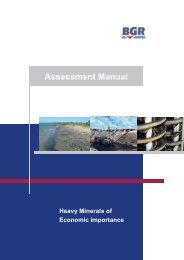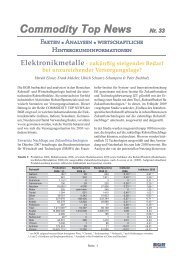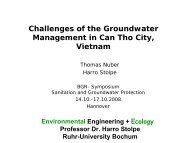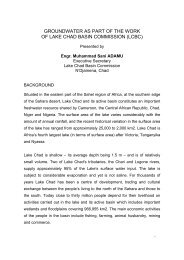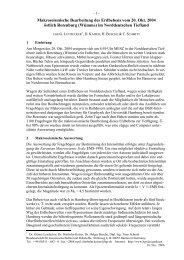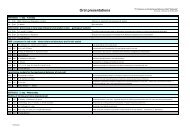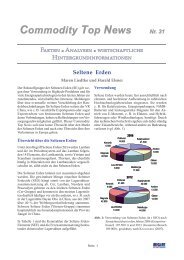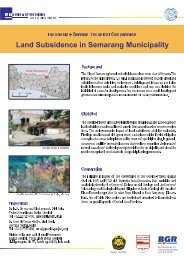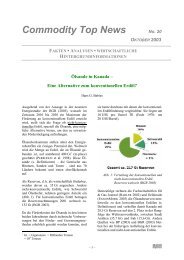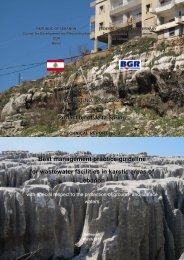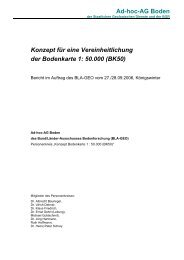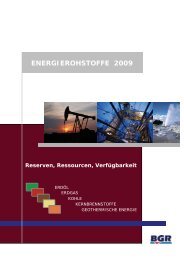THE SMOOTH SOUNDING GRAPH. A Manual for Field Work ... - BGR
THE SMOOTH SOUNDING GRAPH. A Manual for Field Work ... - BGR
THE SMOOTH SOUNDING GRAPH. A Manual for Field Work ... - BGR
You also want an ePaper? Increase the reach of your titles
YUMPU automatically turns print PDFs into web optimized ePapers that Google loves.
Case 2 (Fig. 10)<br />
16<br />
Now we observe a very thin layer at the surface with the resistivity ρ1 un-<br />
derlain a layer with the resistivity ρ2 down to infinity. The spacing of cur-<br />
rent electrodes between A and B is now very large. In the middle between<br />
them there are the potential electrodes M and N. Thus the case will result,<br />
as if the current electrodes touch the second layer: ρ ≈ ρ2<br />
If we calculate by aid of the <strong>for</strong>mula<br />
U<br />
ρ = K , we obtain two different<br />
I<br />
ρ-values <strong>for</strong> both cases. In the following this fact shall be explained in<br />
Fig.11.<br />
The distance of the current electrode from the centre point L/2 is marked<br />
on the abscissa (L/2-scale) and the resistivity ρ, which is measured using<br />
the <strong>for</strong>mula<br />
U<br />
ρ = K on the ordinate. In the first case we have ρ ≈ ρ1 and<br />
I<br />
in the second ρ ≈ ρ2. Now we have to ask how to reach ρ2 starting from ρ1.<br />
U<br />
Which way the ρ-values calculated by the <strong>for</strong>mula ρ = K will run from<br />
I<br />
ρ1 to ρ2 depends on the depth of the layer boundary in comparison to the<br />
actual distance L of the current electrodes. If we do not know anything<br />
about the underground, and if we simply use the values from the <strong>for</strong>mula<br />
<strong>for</strong> the homogeneous underground, the resistivity ρ will not keep con-<br />
stant. Intermediate values of ρ between ρ1 and ρ2 will occur. These inter-<br />
mediate values are named "apparent resistivities ρa“, which really do not<br />
exist in the underground. There<strong>for</strong>e these apparent resistivities have to be<br />
defined as a function of the electrode spacing. We do this by using the<br />
<strong>for</strong>mula <strong>for</strong> the homogeneous earth<br />
ρ a =<br />
def<br />
U<br />
K<br />
I<br />
(13)<br />
The graph combining the values <strong>for</strong> the apparent resistivities ρa and run-<br />
ning from ρ1 to ρ2 is the so-called "sounding graph" ρa( L<br />
2 ).<br />
We summarize: The apparent resistivity depends on theelectrode ar-<br />
rangement on the earth’s surface. Its values must not really occur in the<br />
underground. They are no “true” resistivities. The reason <strong>for</strong> using them<br />
is our ignorance about the real resistivity distribution in the underground.



